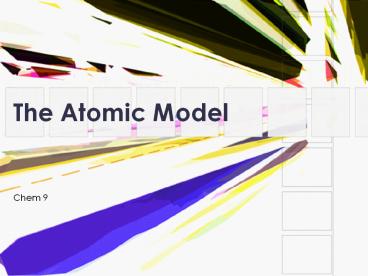The Atomic Model - PowerPoint PPT Presentation
1 / 12
Title:
The Atomic Model
Description:
The Atomic Model Chem 9 The Greek Model Democritus - A Greek Philosopher, 400 BC. Concluded that matter could not be divided into smaller and smaller pieces forever. – PowerPoint PPT presentation
Number of Views:118
Avg rating:3.0/5.0
Title: The Atomic Model
1
The Atomic Model
- Chem 9
2
The Greek Model
- Democritus - A Greek Philosopher, 400 BC.
- Concluded that matter could not be divided into
smaller and smaller pieces forever. - Eventually, the smallest piece of matter would be
found. - He used the word "Atomos meaning indivisible.
3
The Dalton Model Billiard Ball Model
- John Dalton - The English chemist that proposed
- first Atomic Theory in 1803.
- All elements are composed of indivisible
particles. - Atoms of the same element are exactly alike.
- Atoms of different elements are different.
- Compounds are formed by joining atoms of two or
more elements
4
The Thomson Model Chocolate Chip Cookie
ModelPlum Pudding Model
- J. J. Thomson 1856 1940 (English scientist)
- discovered negative particle (an Electron) in
1887 - by using a cathode ray tube
- initially called electrons CORPUSLES
5
Robert A. Millikan (1868 1953)
- 1900 mass of Electron approximately 1/2000 the
mass of a Hydrogen atom - 1916 -determined the charge carried by an
electron - Millikan OIL DROP EXPERIMENT
6
Eugene Goldstein (1850 -1930)
- 1866 Eugene Goldstein found Positive particle
Protons - He named them CANAL RAYS
7
Sir James Chadwick 1891 - 1974
- Discovered
- the neutron in 1932
- Has no charge
- Neutrons mass is close to protons mass
8
Ernest Rutherford - British Physicist Gold Foil
Experiment
- In 1908, proved the atom had a small,
- dense, positively charged Nucleus.
- He said an atom is mostly empty space and
- negative electrons are scattered around
- the outside edge.
9
Niels Bohr (Danish scientist)The Planetary
Model - 1913
- Bohr proposed
- Electrons move in definite orbits around the
nucleus, like planets moving around the sun. - That each electron moves in a specific energy
level.
10
Quantum Mechanical Model
- Erwin Schrodinger (1887-1961)
- -Electrons have NO definite path in an atom.
- -Only a probable location is known based
- on how much energy it has.
- -Atomic orbitals (s,p,d,f) are NOT fixed paths
as Bohr suggested
11
(No Transcript)
12
Summary
- Dalton Solid Sphere
- Thomson Pos. neg mixed together
- Rutherford Positive nucleus, neg electrons
surrounding it - Bohr Positive nucleus, neg electrons in exact
orbits - Quantum Mechanical Theory
- (Electron cloud theory)































